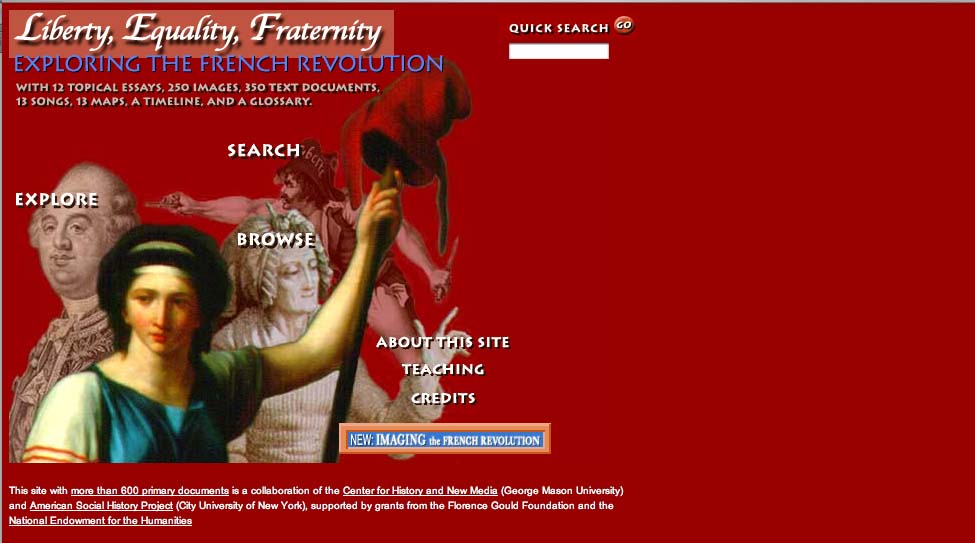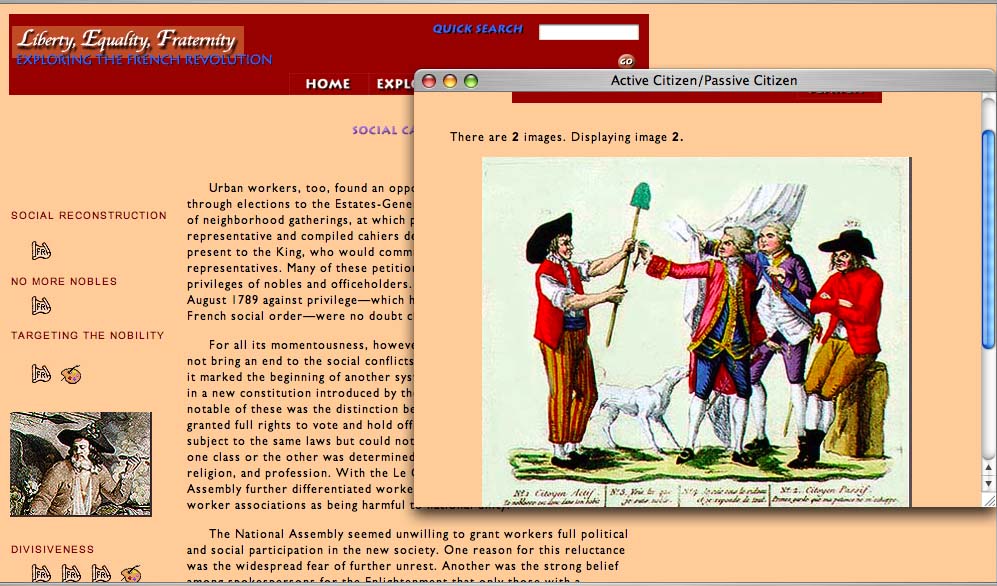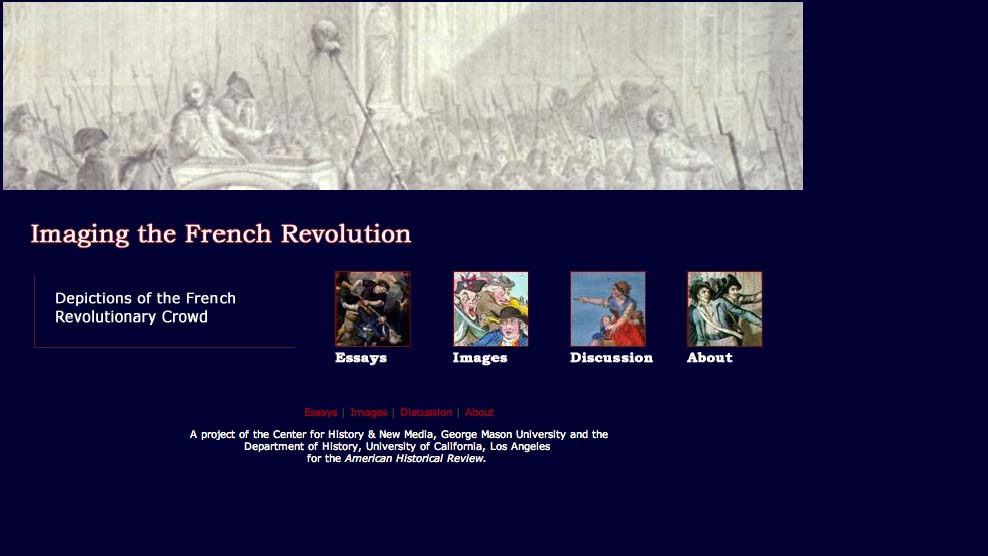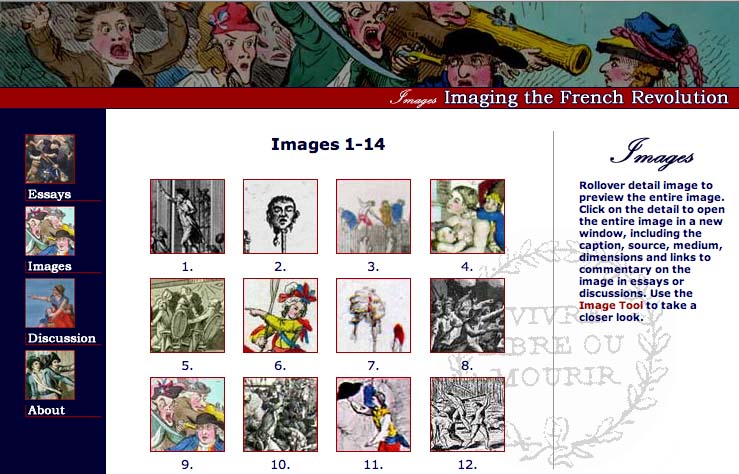« Online Science For The Wired Classroom: The "Disease Spread" Gizmo from Explore Learning | Main | Learning from the Simulated Fruit Fly »
December 13, 2005
"Liberty, Equality, Fraternity" and "Imaging The French Revolution:" Two Generations of Digital Texts

Since 1994, Roy Rozensweig's Center For History And New Media at George Mason University has pioneered the use of digital media to document and analyze historical events. Their particular focus is to transform history from an elite activity practiced mainly in the academy to a more democratic form of inquiry that both draws on and appeals to new audiences. Thus far, they have sponsored over a dozen ambitious digital history projects, ranging from the widely heralded September 11 Digital Archive to a digital recreation of P.T. Barnum's 19th century New York City museum of oddities.
In this review, I'll be looking at two CHNM-sponsored efforts -- Liberty, Equality, Fraternity and Imaging the French Revolution -- that explore the cultural history of eighteenth century France through both scholarly analysis and an extensive archive of cultural artifacts. Seven years divide the production of the two sites: Liberty, Equality, Fraternity was published by the Center in 1998, while Imaging The French Revolution was published in early 2005 as part of a joint effort with American Historical Review,. While both sites are engaging and useful, both also reflect the moment of their production: they thus can tell us something about the history of digital publishing even as they provide a deeper understanding of the history of the French Revolution.
Liberty, Equality, Fraternity is a collaboration between the CHNM and the American Social History Project, a center at the City University of New York which shares CHNM's goal of revitalizing the study and teaching of history through the use of digital tools. Prior to working on Liberty, Equality, Fraternity, the Social History Project partnered with Voyager to produce a digital edition of their award-winning textbook Who Built America, which is still available as two seperate CD-ROMs (the second CD-ROM was produced in the post-Voyager era by Worth Publishers).
Like Who Built America, Liberty, Equality, Fraternity has a CD-ROM component: those interested in the project can either rely exclusively on the website or purchase an accompanying text and CD-ROM from Penn State University Press. The decision to produce a CD-ROM stems partly from the fact that when the site was first published in 1998, this form of extensive online scholarship was still in its pre-adolescence. In 2005, it's far more likely to find a project such as this one authored entirely on the web (or published as a textbook with a password-protected website), but back then the availability of broadband was not something to be taken for granted. The CD-ROM also contains video interviews that aren't available online at all for much the same reasons. It's also possible that the authors found it hard to conceive of a project as ambitious as this without thinking of it in the context of a published volume.
In any case, both versions of Liberty, Equality and Fraternity work well as texts for teaching the revolution; they pair substantial scholarly research with an extensive archive of maps, songs and images. Depending on their specific needs, users of the Liberty, Equality, Fraternity can choose from three main navigational paths -- explore, search, and browse. The "explore" section features twelve essays, written by historians Lynn Hunt of UCLA and Jack Censer of George Mason University, that can be accessed through a drop-down menu. Ten of these provide a succinct history of the Revolution, covering topics including the social causes of revolution, the fall of the monarchy, women and the revolution, the story of Napoleon, and the revolution's legacy in France and elsewhere. Two further essays provide analytic tools for scholars interested particularly in imagery or songs from the period.
Once the user moves past the main menu window, the "look" of the site is, on the whole, somewhat spartan. In the case of the essays, the type is on the small side, though readable: a series of icons running down the left side of the page signal hyperlinks to primary source documents. In the image below, for example a political cartoon, "Active Citizen/Passive Citizen," is used to illustrate an essay on the social causes of the Revolution.

The images, songs and maps on the site -- along with a timeline and glossary -- can be accessed through the "Search" or "Browse" function, depending on whether the user knows in advance what they're looking for. There is wonderful material here: 245 images including political cartoons and pictures of decorated fans and porcelain from the period, 338 documents including personal memoirs, official reports, treatises and eyewitness accounts, 13 maps created especially for the project, and finally, 13 songs also produced uniquely for the project by musicians who worked from an 1899 songbook Playable in Quicktime, the songs are transcribed and translated in pop-up windows.
Interestingly, at the time the Center negotiated for permissions for their visual documents in Liberty, Equality, Fraternity, they paid much less than they would have had they wanted to include them in a print volume: recently, however rights holders have been asking for much higher royalty fees for the display of images and documents online.
Overall, Liberty, Equality, Fraternity is a site that works a bit better than it looks. Students and scholars can use the site both as a textual introduction to the French Revolution and as a valuable archive of visual and aural resources, but the project's visually bland and formally conservative interface is unlikely to encourage the uninitiated to explore the site. It's difficult to fault the site for this -- it relies on design tools and protocols that have shifted over time. As a digital classroom text, it certainly exceeds what a conventional paper text can do: it's just that the medium has evolved since the site was put online, both in terms of how archives are organized and in terms of the way in which the medium itself is often intertwined in the scholar's process of research and presentation.

To get a sense of the evolution of the digital history text, click a button at the bottom right corner of the home page of Liberty, Equality, Fraternity and look at the site Imaging The French Revolution, a later work also authored by Censer and Hunt in collaboration with the CHMN. Imaging The French Revolution builds on and updates the original project by using recent developments in digital scholarship to take a closer look at some of the original primary source material. Described as "an experiment in digital scholarship," Imaging The French Revolution features seven essays from seven scholars asked to analyze forty-two images of crowds and crowd violence stored in a shared archive. These images, drawn from the original site, are made available in a fresh interface along with a flash-based "Image Tool" (created by a 12-year-old programming wiz) that allows them to magnify and layer images in order to draw their own conclusions.

Part of the value of Imaging The French Revolution, then, stems from the way the user is positioned within the site -- not as a passive browser of archived information, but as an active observer who can use the image tool both to think through the images on their own and to interrogate the decisions made by the seven scholars who describe them. In the process of interrogating these decisions, the user can also access online discussions between these seven scholars that took place before they actually wrote their essays. All seven met during the summer of 2003 on an online forum to discuss issues of interpretation, methodology and the impact of digital media on scholarship: the discussion they had then filtered down into their final analytical work.
In other words, Imaging The French Revolution is innovative in two primary ways: it incorporates the user into the piece in a more interactive fashion, and it incorporates the digital medium into the process of knowledge-making -- a method of inquiry that has become increasingly common among saavy digital scholars. There's another way that Imaging The French Revolution reflects the current moment in online scholarship: as an "online-only" publication of American Historical Review, it is a sign of the changing attitudes towards digital scholarship. In 1998, the authors of Liberty, Equality, Fraternity felt the project needed an offline component to be both respectable and accessible; in 2005, the same authors were comfortable working on an online-only project for a journal whose readership had been primarly print-based until recently.
So what does this have to tell us about the future of the digital text? For one thing, it suggests that now that it has become more commonplace to find deep, rich online archives, we might come to expect more of the archive: rather than simply celebrating the fact that material is accessible, more attention will be paid to the conditions and interface of that accessibility. At the same time, it's also an indication that scholars are increasingly willing to eschew paper-based scholarship for serious scholarly analysis that embraces the methodological shifts implicit in the digital medium.
Posted by lisa lynch at December 13, 2005 3:18 PM
